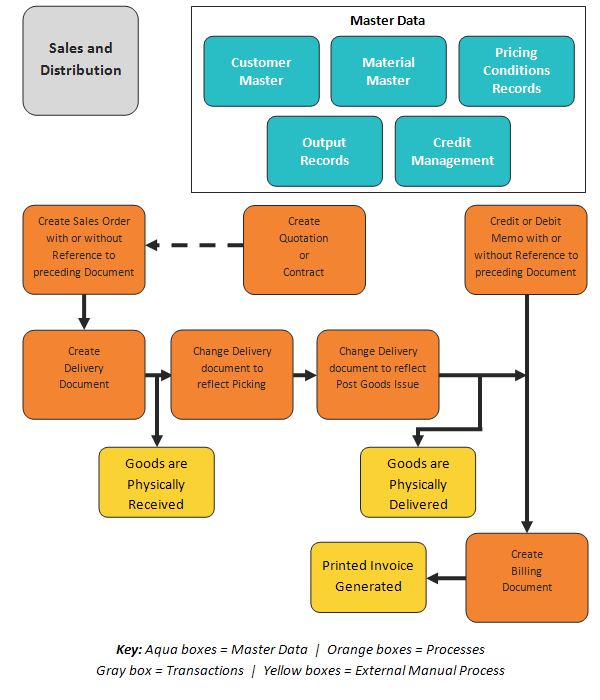
- •Introduction to sap
- •Sap Module Introduction
- •Sap business bydesign
- •Sap business one
- •About sap supplier relationship management software
- •About sap xapps
- •Sap Financial Accounting (sap fi)
- •Financial Accounting includes the following sub-modules:
- •Business process associated with the sap fi module:
- •Sap Financial Supply Chain Management (sap fscm)
- •Business process associated with the sap co module:
- •Subcomponents of the sap Controlling (sap co) Module:
- •Sap Sales and Distribution (sap sd)
- •Order to Cash business process associated with the sap sd module:
- •Subcomponents of the sap Sales and Distribution (sap sd) Module:
- •Sap Logistics Execution (sap le)
- •Sap Production Planning (sap pp)
- •Diagram of the typical Plan to Produce business process associated with the sap pp module:
- •Sap Production Planning (sap pp) is compromised of the following modules:
- •Sap Quality Management (sap qm)
- •The Quality Management (qm) process can integrate with the following sap modules:
- •Sap Plant Maintenance (sap pm)
- •Both Corrective and Preventative maintenance processes exist in the Plant Maintenance module.
- •Subcomponents of the sap Plant Maintenance (sap pm) Module:
- •Sap Project System (sap ps)
- •Common processes in Project System include:
- •Sap Human Resources (sap hr)
- •Sap Human Resources (hr) Components or Sub-Components:
- •Typical Hire to Retire business process associated with the sap hr module:
Sap Sales and Distribution (sap sd)
The Sales and Distribution (SAP SD) consists of all master data, system configuration, and transactions to complete the Order to Cash process. It includes the following information and processes:
Customer Master and Material Master data
Sales Orders
Deliveries
Pricing
Billing
Credit Management
Order to Cash business process associated with the sap sd module:

Subcomponents of the sap Sales and Distribution (sap sd) Module:
Master Data
Sales Support
Pendulum List Indirect Sales
Sales
Shipping and Transportation
Billing
Empties Management
Credit Management
Foreign Trade/Customs
Sales Information System
This is brief review of the components and processes associated with the SAP SD module. For a more in-depth understanding of the Sales and Distribution module, please review our available SAP Sales and Distribution training.
Please Note: The Learn SAP pages on this site are intended to be brief summaries for SAP customers who are encountering SAP for the first time. For more advanced knowledge, please review the articles in our SAP Library, and our SAP Trainingofferings for both Super Users and Project Teams.
Sap Logistics Execution (sap le)
Logistics Execution covers the areas of Warehouse Management and Inbound Receiving and Outbound Shipping processing. Warehouse Management provides an additional level of stock location detail than SAP Inventory Management. Inventory Management only maintains stock quantities at the Storage Location level, which is typically an area of your warehouse or a building on your company's campus. Warehouse Management manages stock down to the bin level, or to the physical coordinates within your warehouse. Warehouse Management also provides Picking and Putaway Strategy functionality. The following diagram illustrates a typical Outbound Process using Warehouse Management:

This is brief review of the components and processes associated with the SAP LE module. For a more in-depth understanding of the Logistics Execution module, please review our available SAP Logistics Execution training.
Please Note: The Learn SAP pages on this site are intended to be brief summaries for SAP customers who are encountering SAP for the first time. For more advanced knowledge, please review the articles in our SAP Library, and our SAP Trainingofferings for both Super Users and Project Teams.
Sap Production Planning (sap pp)
Production Planning consists of all master data, system configuration, and transactions to complete the Plan to Produce process. It includes the following information and processes:
Material Master, Bill of Material, Routing and Work Center data
Sales and Production Plans
Long Term Planning
Demand Management
Material Requirements Planning (MRP)
Capacity Planning
Production Orders
KANBAN
Diagram of the typical Plan to Produce business process associated with the sap pp module:

Sap Production Planning (sap pp) is compromised of the following modules:
Master Data - includes the material master, work centers, routings and bill of materials.
SOP - Sales and Operations Planning (SOP) provides the ability to forecast sales and production plans based on historical, current and future data.
DRP - Distribution Resource Planning allows companies the ability to plan the demand for distribution centers.
Production Planning - includes material forecasting, demand management, long term planning and master production scheduling (MPS).
MRP - Material Requirements Planning relies on demand and supply elements with the calculation parameters to calculate the net requirements from the planning run.
Shop Floor Control - includes the processing of production orders, goods movements, confirmations and reporting tools for production.
Capacity Planning - evaluates the capacity utilized based on the work centers available capacity to show capacity constraints.
Repetitive Manufacturing - in repetitive manufacturing, the manufacturing process is usually simple in that the same products are produced over a long period of time. This module provides the transactions and business process for companies to run repetitive manufacturing in SAP.
KANBAN - is a process of replenishment based on a pull system using KANBAN cards to generate the replenishment cycle.
Product Cost Planning - is the process of evaluating all the time values and value of component materials to determine the product cost.
This is brief review of the components and processes associated with the SAP PP module. For a more in-depth understanding of the Production Planning module, please review our available SAP Production Planning training.
Please Note: The Learn SAP pages on this site are intended to be brief summaries for SAP customers who are encountering SAP for the first time. For more advanced knowledge, please review the articles in our SAP Library, and our SAP Trainingofferings for both Super Users and Project Teams.
